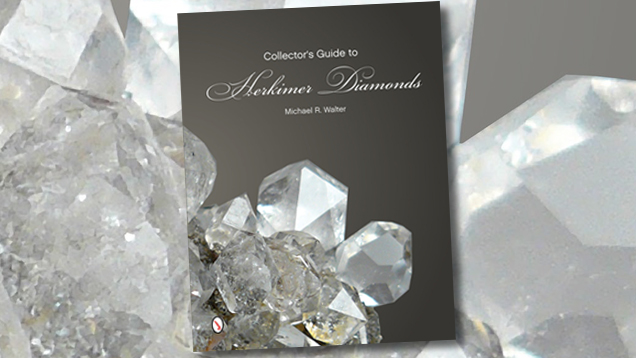Book Review: Collector’s Guide to Herkimer Diamonds

Quartz, chemically the simplest form of the silicates, is abundant in the earth’s crust. Herkimer diamonds are a unique form of quartz crystal found in the state of New York. Most of the brilliant, water-clear crystals show the classic 18-sided, doubly terminated hexagonal form.
Author Michael Walter gives us an in-depth look at every aspect of Herkimer diamonds. Mineralogical properties such as crystal shapes, sizes, surface growth features, and crystal combinations are fully described. Calcite, dolomite, iron sulfides, and hydrocarbons are associated minerals. Inclusions that provide clues to the origins of the Herkimer diamonds are solids, liquids (salt water or petroleum), gases (most often carbon dioxide), two- and three-phase inclusions, and negative crystals. Anthraxolite, formed by polymerization of petroleum over geological time periods, is the most common solid inclusion.
The geological history of Herkimer diamonds is an intriguing one that begins at the bottom of a shallow sea about 495 million years ago. The material that would later form the crystals was deposited as a waxy organic material along with quartz sand and masses of pyrite. All of this was encased in a rock made up of two carbonate minerals: dolomite and calcite. Sediments slowly buried the rock and its temperature rose. As a result, molecules that had been holding quartz dissolved from the sand in solution were broken apart by thermal splitting. This caused the quartz to come out of solution very slowly and resulted in the growth of quartz crystals of exceptional clarity.
The book’s main purpose is about where to go for treasure hunting and how to work the rock based on firsthand experience. No single aspect of field collecting goes undiscussed. Collecting is only possible during the favorable weather of summer. The rock is hard, and the author gives invaluable information on equipment and tools and how to use them. Specific methods used to effectively extract Herkimer diamonds are described.
A full chapter is dedicated to the preparation of specimens: cleaning, trimming and preservation. Some of the mines are operated as fee locations and open to the general public. These and some closed mines and locations outside the traditional Herkimer diamond region are documented. A handy appendix section contains maps and GPS coordinates of Herkimer diamond localities, including Ace of Diamonds, Herkimer Diamond Mines, Crystal Grove Mine, Diamond Acres, and Hickory Hill.
Good rock and mineral collecting field guides are hard to find. This guide offers 210 vivid color images and a well-written, easy-to-read text. This book is a must have if you are thinking of prospecting for Herkimer diamonds.



